Papers by Dr Shuva Chowdhury
Problems and Solutions of Point Cloud Mapping for VR and CAVE Environments for Data Visualization and Physics Simulation
Multimodality in Virtual Co-urban Design
Frontiers in Built Environment, 2024
The study proposes incorporating human bodily comfort performance through a simulation method to ... more The study proposes incorporating human bodily comfort performance through a simulation method to assess the impact of urban microclimate conditions in an urban campus area. A human comfort performance matrix is used based on PET value and gender's thermal stress conditions. The investigation serves as a way to evaluate open spaces' climatic performance quantitatively through energy simulation. The method shows a way to measure urban comfort regarding gender perspectives early in the urban decision-making process. The findings of this research have practical implications for urban decision-makers to use robust simulation tools to optimize open space configurations based on gender's thermal performances.
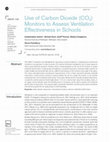
Journal of Sustainable Architecture and Civil Engineering
The COVID-19 pandemic has highlighted the importance of good ventilation in mitigating the transm... more The COVID-19 pandemic has highlighted the importance of good ventilation in mitigating the transmission of airborne virus particles. In many countries, CO2 monitors have been mandated for use in indoor spaces to inform good ventilation practices. However, there is limited guidance on the use of CO2 monitors to assess ventilation performance in large groups of buildings. In occupied classrooms, locating multiple monitors to collate reliable environmental data can be a difficult task because of the functions and usage of the space. This study used observations and physical measurements of CO2 in three real-world naturally ventilated classrooms, in three primary schools to assess whether the use of a single CO2 monitor, in one location could predict the room ventilation performance. The results indicate that for naturally ventilated classrooms, a single CO2 monitor placed at head height (about 1.5 m) on a vertical wall, away from windows, doors, or air supply, and not directly under th...
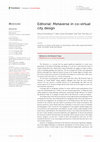
Frontiers in Virtual Reality
The Metaverse is a concept that has gained significant popularity in recent years, particularly i... more The Metaverse is a concept that has gained significant popularity in recent years, particularly in the field of technology and design. It is not just a mere Research Topic of virtual environments but a shared space where individuals can engage in various activities, such as socialising, gaming, and commerce. The rise of improved Virtual-and Augmented Reality technologies has reopened research avenues in the broader digital co-design realm. One of the critical areas of research in this field is the design of co-virtual cities, where users can interact with each other in a virtual environment. We have been researching this area for quite some time. Hence this Research Topic of 'Frontiers in Virtual Reality' brings together colleagues who share the same research interests. We now present a carefully selected set of undertakings that delve into the various aspects of co-virtual city design and how this realm can be leveraged to create new and innovative experiences. Co-design refers to designing a product or service with the active participation of the users who will ultimately use it. Akin to our own research approaches, co-design has been widely adopted in urban planning, architecture, and product design. However, we realised that Research Topic of 'co-design of virtual cities in the Metaverse' is still in its infancy. The unique nature of the Metaverse presents several opportunities and challenges for the co-design of virtual cities. One of the benefits of co-designing virtual cities in the Metaverse is increased user engagement: by involving users in the design process, they become more invested in the outcome and more likely to participate in the virtual environment. The process can lead to a more vibrant and active community, as users feel a sense of ownership and belonging to "their" virtual city. The engagement of users gathers valuable insights into user preferences and requirements and designers can gain a deeper understanding of their needs, desires, and limitations. This information can then create virtual cities that better meet the users' needs, leading to increased satisfaction and engagement. It also has the potential for increased creativity and innovation. By involving a diverse group of users in the design process, designers can tap into a wealth of ideas and perspectives they may not have considered otherwise. It can create unique and innovative virtual cities that offer users a new and exciting experience. However, co-designing virtual cities in the Metaverse also presents significant challenges. One of the biggest challenges is ensuring the participation of a diverse group of users. It is essential to involve a broad range of users with different backgrounds, experiences, and
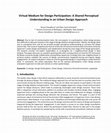
Due to lack of communication tools, the non-experts in a participatory urban design process face ... more Due to lack of communication tools, the non-experts in a participatory urban design process face difficulty to take part actively in the stage of design ideation and generation. Mostly, the design ideas stay in conceptual form and do not provide enough perceptual understanding to conceive the design actions fully. The research hypothesises that an Immersive Virtual Environment (IVE) instrument enhances layperson's urban design participation and collaboration during the early stage of the design generation. The research involves non-expert stakeholders as co-designers for a neighbourhood design in New Zealand. The paper discusses as a parallel reporting with other coming articles on how the IVE instrument facilitates successful design collaboration among fellow laypersons to design their own neighbourhood. A protocol analysis validates the success of design communication happened during non-experts design engagements. An expert evaluation is done to rank the generated design in responding to understand the ideas. In conclusion, the article speculates that an IVE assisted participatory urban design process empowers laypersons to take part actively in urban spatial design.

Co-presence in Remote VR Co-design: Using Remote Virtual Collaborative Tool Arkio in Campus Design
CAADRIA proceedings
A participatory co-design approach is most often counted as a time-consuming method and ends with... more A participatory co-design approach is most often counted as a time-consuming method and ends without any concrete solution. Since the new evolution of virtual reality-based communication tools, researchers are trying to integrate citizens in the spatial design making process in-situ situation. However, there has been little research on how remotely co-presence in VR can integrate end-users in a co-design environment in re-envisioning their own using spaces. This study adopts a remote VR collaborative platform Arkio to involve novice designers remotely to design their known urban places. Participants are in three different virtual communication systems. Groups can actively engage in co-creating 3D artefacts relevant to a virtual urban environment and communicate through audio together in a remote setting. The platform was tested with a group of graduate students. The given design task was to re-envision the urban places of their academic institute campus. The sessions have been recorded and transcribed for analysis. The analysis of remote conversations shows that co-presence existed while they were engaged in co-design.
A Transformative Computation Collaborative Design Approach to Leverage Non-Experts in Generating Urban Furniture
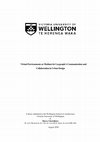
The distance between urban design processes and outcomes and their communication to stakeholders ... more The distance between urban design processes and outcomes and their communication to stakeholders and citizens are often significant. Urban designers use a variety of tools to bridge this gap. Each tool often places high demands on the audience, and each through inherent characteristics and affordances, introduces possible failures to understand the design ideas, thus imposing a divergence between the ideas, their communication and the understandings. Urban design is a hugely complex activity influenced by numerous factors. The design exploration process may follow established design traditions. In all instances, the medium in which the exploration takes place affects the understanding by laypeople. Design tools are chosen, in part, to facilitate the design process. Most urban design community engagement does not use Virtual Environments (VE) as a means of communication and participation in the early stage of the design generation. There has been little research on how the use of ...
Augmented Reality and Its Application, 2022
Bringing the designer’s concept to the non-design expert’s communicative level requires a signifi... more Bringing the designer’s concept to the non-design expert’s communicative level requires a significant understanding of the communication media. Primarily the design communication depends on the type of the tools used. Virtual tools with their pre-set operability limit the designer’s ways of interaction with the artefacts. This article proposes a framework for designers to interact with non-design experts through an enhanced communicative media. The design framework indicates steps of design thinking to develop the interface by understanding both the virtual artefacts’ perceptual affordance to the users and the design task. The paper discusses about projects tested in three different scenarios, urban design, architecture, and product design. It concludes with the arguments on designers’ role as authors of the system design.

A Framework for Virtual Co-Urban Design
Urbanie & Urbanus - Smart City?, 2021
Traditionally, professionals’ urban design methods and tools do not allow users to be active in t... more Traditionally, professionals’ urban design methods and tools do not allow users to be active in the design process. On the contrary, participatory design processes build the citizen’s capacity of traditionally omitted city building procedures. The participants act as individual actors in the participatory design process, and a social hierarchy exists among them. The visual information adheres to the design artefacts used in the process stay in assumptions and leads to an unsolved conclusion with an expense of time. The article argues that immersive virtual reality equipped with producing instantaneous design artefacts and design engagement set-up brings conclusion at the early stage of an urban design process. The design task, the perceptual understanding of the virtual environment and the feeling of affiliation are the catalysts to keep the flow of the conversation. The design experts set design tasks understanding the capacity of the virtual tools and the need for the design probl...
Developing A Novel Method for Stakeholder Engagement in Designing New Zealand's Neighbourhoods
Density while used frequently as criteria of cities is not fully adequate in describing qualitative aspects of urban form
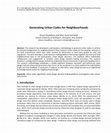
This research has developed a participatory methodology to generate urban codes to achieve the de... more This research has developed a participatory methodology to generate urban codes to achieve the desired configuration for neighbourhoods in New Zealand. Urban codes are the qualities inherent in the built environment which have either evolved by themselves or have been guided by rules and regulations. The work develops a novel decision‐making platform that brings together city level and local neighbourhood data to aid participatory urban design decisions. This platform offers stakeholder collaboration and engagement in complex urban design decision‐making processes. The research develops a configurational design method by employing virtual instruments to generate building forms. The research methodology establishes a middle approach between top‐down and bottom‐up urban design methods where the generated urban forms can be visualised in an online platform for stakeholders to get real‐time feedback. In particular, it explores an alternative urban design process as an algorithmic knowle...
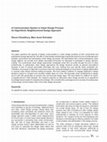
Our paper questions the aspects of design communication in urban design practices of both convent... more Our paper questions the aspects of design communication in urban design practices of both conventional and participatory design approaches. We offer a virtual design methodology to generate urban form as a middle approach between conventional and participatory urban design processes. We hypothesise that a virtual participatory urban design platform can provide more design associated information for laypeople to participate in design decisionmaking. The conventional urban design approaches investigate urban form as purely through the lens of urban professionals. In participatory urban design approaches the design decisions remain as general assumptions because of lack of enough associated information like cost, building form and real-life visual perception etc. Therefore, we propose an approach to produce urban form taking advantages of virtual tools to engage stakeholders in complex urban design decision-making processes. We have created a platform to engage laypeople in design iter...
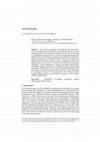
The recent development in Virtual Reality (VR) allows for novel engagement in participatory urban... more The recent development in Virtual Reality (VR) allows for novel engagement in participatory urban design. Despite that any design approach cannot include and address all items that are relevant or needed during a design process, social VR design instruments offer additionality via their real-time generation and visualisation possibilities that are unmatched in conventional realms. The research employs an anthropogenic approach to design research to engage end-users in the design process. An Immersive Virtual Environment (IVE) instrument 'SketchPad' allows laypersons to design successfully urban forms. SketchPad engaged laypersons in a meaningful design discussion and generations of urban spaces. The research discusses the findings of the experiments. The paper concludes with a reflection of how non-experts as co-designers can use IVE instruments to drive change of their neighbourhood proactively and to positively impact on the liveability of their neighbourhood.

Virtual environments as medium for laypeople to communicate and collaborate in urban design
Architectural Science Review, 2020
Regarding laypeople’s active participation with artefacts in the early stage of urban design, the... more Regarding laypeople’s active participation with artefacts in the early stage of urban design, there is a certain difference between conventional urban design process and participatory urban design process. The design artefacts used in the conventional urban design process do not allow laypeople to take part actively in the early stages of the design process. Similarly, in the participatory design process, the generated design ideas remain hidden in assumption due to the lack of associated information of the artefacts and the participants perform as individual actors. The research speculates that a virtual immersive participatory design instrument can reduce the gap, where the participants can act together as a unit to produce authentic design outcomes. An Immersive Virtual Environment (IVE) assisted design experiment set-up has developed for laypeople to engage in a shared and enhanced communicative platform. The article reports the procedure of developing the instrument and discusses them in terms of design communication, participation and expert’s role. It concludes with a reflection of how laypeople as co-designers can use IVE instruments to design their neighbourhood meaningfully.
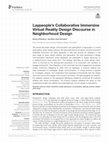
Frontiers in Robotics and AI, 2019
The article discusses design communication and participation of laypeople in a virtual participat... more The article discusses design communication and participation of laypeople in a virtual participatory urban design process. We speculate that an immersive virtual environment facilitated instrument can allow laypeople to take part actively as designers in the early stage of urban design ideation and generation. We have developed a design communication framework where laypeople can participate in design discourse on a neighborhood's future urban form. The strategy describes an urban design intent, which is informed by the development procedure of an instrument and workflow to engage participants. The integration of the instrument and the engagement procedure enable continuous designing of urban form by laypeople. A protocol analysis has been undertaken to investigate design communication. A coding scheme is applied to investigate, analyse, and understand how laypeople communicate with the design instrument and control design in the virtual environment. Through engaging non-experts, the research impacts on the perceptual affordance created by immersive 3D buildings artifacts and verbal conversation. The protocol analysis validated the setup so that subsequent studies can address the meaningfulness of such design conversations.
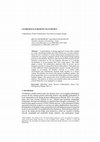
CAADRIA, 2022
A participatory co-design approach is most often counted as a time-consuming method and ends with... more A participatory co-design approach is most often counted as a time-consuming method and ends without any concrete solution. Since the new evolution of virtual reality-based communication tools, researchers are trying to integrate citizens in the spatial design making process in-situ situation. However, there has been little research on how remotely co-presence in VR can integrate end-users in a co-design environment in re-envisioning their own using spaces. This study adopts a remote VR collaborative platform Arkio to involve novice designers remotely to design their known urban places. Participants are in three different virtual communication systems. Groups can actively engage in co-creating 3D artefacts relevant to a virtual urban environment and communicate through audio together in a remote setting. The platform was tested with a group of graduate students. The given design task was to re-envision the urban places of their academic institute campus. The sessions have been recorded and transcribed for analysis. The analysis of remote conversations shows that co-presence existed while they were engaged in co-design.







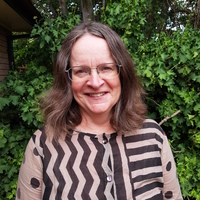
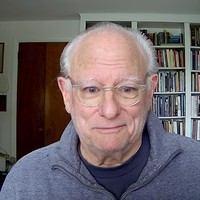

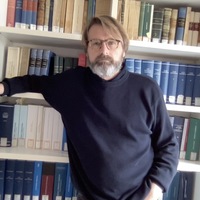
Uploads
Papers by Dr Shuva Chowdhury